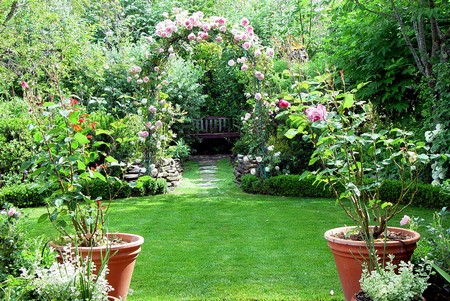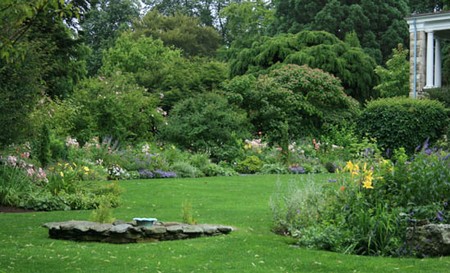Although there are various ways to make garden compost, all have the same objectives in common, to create ideal conditions for beneficial bacteria to thrive. A warm, well aerated, free draining, non-acidic environment is needed. Success with compost depends on a healthy population of bacteria, which break down green vegetation into the sweet smelling, brown, crumbly, valuable manure known as garden compost.
COMPOSTING IN BINS
The easiest and tidiest way to make good compost in a small garden is to use a proprietary compost bin of some sort. Bins with slatted wooden sides are traditional, and when lidded they provide close to ideal conditions. Those with one side that is removable make for ease of access.

Plastic bins with perforated, insulated sides keep in warmth and regulate aeration; their tight-fitting lids reduce heat loss to a minimum and keep out rain, so eliminating the wash-out of valuable nutrients. In small gardens it is often best to opt for the type of bin where green material is fed in at the top and rotted compost forked out at the bottom, as an ongoing process.
Another useful type of plastic bin has sloping unperforated sides. In use the bins are simply lifted off to expose the rotted compost. It is very important not to over-consolidate in this type of bin, so read the maker’s instructions carefully.
In large gardens, consider two or even three bins, with the idea that as one bin is being filled another is rotting down and a third being emptied.
A cheaper alternative to bins is to build up the compost in a free-standing heap. Provided the heap is kept covered with heavy duty plastic, well weighted down at the corners to exclude rain and keep in warmth, a free-standing heap is quite satisfactory. However, aim to make the heap at least 90 cm (3 ft) square to create sufficient warmth. The chief drawback to this method is that freestanding compost heaps always tend to look rather untidy in small gardens.
Making the compost
Whether you are working with containers or freestanding heaps, unless a bin with a fixed perforated base is being used, begin by creating a well drained base. An 8 cm (3 in) layer of brushwood is best, but stones will suffice. Healthy vegetation waste is then built up, sandwich fashion, gradually throughout the season. Lay down layers of about 10 cm (4 in) at a time, alternating the green materials with a sprinkling of general fertilizer. The alternative is to use proprietary compost activator as the makers recommend.
The more varied the mix of waste materials the better. Aim for a balance of coarse waste and fine. Chop up coarse materials and mix with the likes of lawn clippings. Dry fibrous materials will not rot down satisfactorily on their own; and if too much soft, succulent waste is included, such as unrelieved grass clippings, the compost is likely to lack aeration and become a slimy, evil-smelling mass. A good sample of garden compost has a pleasantly earthy smell — and is brown and crumbly in texture.
What to include
Lawn clippings, annual weeds, household vegetable trimmings, pea and bean haulm, soft deciduous hedge trimmings in moderation and deciduous leaves can all be added to the compost heap/bin. Never include weeds that are setting seeds; difficult perennial weeds like couch, buttercup, nettle, dock, ground elder, thistle and convolvulus; pest and disease infected plants; woody material like brussels sprout stalks; chemically treated weeds or lawn clippings; anything contaminated with creosote or other wood preservative; or cooked vegetable waste and anything greasy — they will only attract vermin.
Where large quantities of compost are envisaged — say, to improve difficult soils — rarely are sufficient quantities of compostable materials available in small gardens. Under these circumstances, it is well worth buying in straw (or similar) to make up bulk. But do first check on the possibility of chemical contamination in the form of weedkillers and the like, and give such products the go by. Perhaps spent hops may be available at a local brewery? They too are useful to make up bulk.

How long does it take?
Compost can be ready to use within four months or less, but a lot depends on the season. Waste put down at the beginning of winter is going to take a lot longer to decompose than the same amount put down in spring. When emptying the bin/heap, use any incompletely rotted compost from the outside to start off the next heap.
MAKING LEAFMOULD
Deciduous leaves (not evergreen) can be included in the general compost bin, but because the addition of any quantity of leaves to the general bin tends to slow down rotting, many gardeners prefer to compost them separately into leafmould. Again, a compost bin is the tidiest way of dealing with leaves. But a cheaper alternative, where space permits, is to construct a compound of about 90 cm (3 ft) square and of a similar depth. Make it in an out-of-the-way spot. Attach chicken wire to four corner posts, line with perforated plastic, and keep covered between fillings. Moist leaves are built up in layers in the same way as when composting general vegetation.